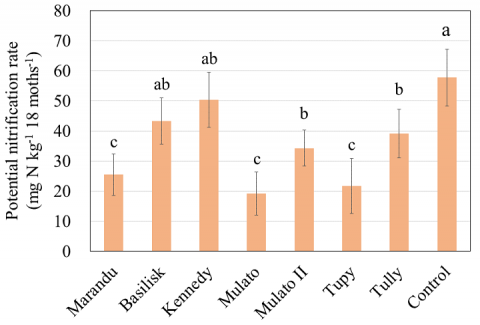Brachiaria reduces nitrification rate through inhibition of Ammonia-oxidizing archaea in inter-plant soil
Description
Modern agriculture requires large amounts of nitrogen (N) to maintain crop yield, but its utilization efficiency is not high. Chemical nitrification inhibitors are used to improve N utilization efficiency, but they are expensive and need to be applied continuously. Biological nitrification inhibition (BNI), a phenomenon in which the plant itself secretes a nitrification inhibitor and exerts its effect, is expected to improve N utilization efficiency in agricultural ecosystems and reduce environmental loads. Many studies have been conducted on BNI plants, especially the tropical pasture grass “Brachiaria,” including the identification of brachialactone as a nitrification inhibitor. However, these studies have targeted rhizosphere soils that directly evaluate the effects of plant root secretions, and although there are many studies, there are very few reports on BNI effect in field experiments. Regarding the expression of BNI, it has been shown that sorghum is related to the suppression of ammonia-oxidizing archaea (AOA) (JIRCAS Research Highlights 2019, A05) but not fully elucidated in Brachiaria. On the other hand, at field scale, it is necessary to evaluate the entire field including not only the rhizosphere soil but also the inter-plant soil. This experiment clarifies the change in the nitrification rate of the bulk soil and its mechanism in the cultivation of tropical grass Brachiaria.Seven varieties of Brachiaria grasses (with different BNI potentials in root exudates) and a bare plot were set as the control plot, and a field cultivation trial was conducted for 18 months at the Tropical Agriculture Research Front (TARF) of JIRCAS (Fig. 1). Among the seven varieties investigated, Tupy has the highest BNI activity in root exudate and Marandu has the lowest (Table 1). The potential nitrification rate in the inter-plant soil (center at 90 cm between stocks, depth 0 to 30 cm) after 18 months of Brachiaria cultivation differs depending on the variety, and among the 7 varieties investigated, 3 varieties (Marandu, Mulato, and Tupy) have particularly inhibited nitrification rates (Fig. 2), and the degree of decrease in the nitrification rate of each variety did not necessarily match the BNI activity of root exudates of each variety (Table 1). Since multiple regression analysis including BNI activity in root tissue enables significant regression, the effect of BNI activity in root tissue reflecting root turnover can be considered. The nitrification rates after 18 months of cultivation were positively correlated with the abundance of AOA in the soil but not with that of ammonia-oxidizing bacteria (AOB) (Fig. 3). The decrease in the number of AOA is the cause of the decrease in the nitrification rate. The study targeted soils collected between Brachiaria plants, so there is a possibility that stronger nitrification suppression occurs in the rhizosphere soil and in the vicinity of the plants.
From these results, the establishment of a crop rotation system utilizing Brachiaria can be expected because previous studies have reported an increase in subsequent crop yields after Brachiaria cultivation.
Figure, table
-
Fig. 1. Picture of field experiment
-
Table 1. Root amount and BNI activities in root exudates and root tissues of seven Brachiaria cultivars
Cultivar Root amount BNI activity in root exudate in root tissue kg DM ha-1 ATU g-1 DM day-1 ATU g-1 DM Marandu 849 2.0 174.9 Basilisk 1,147 18.3 174.5 Kennedy 488 24.4 207.0 Mulato 648 7.0 200.5 Mulato II 855 7.0 202.8 Tupy 699 46.3 208.6 Tully 1,109 17.5 183.2 ATU (allylthiourea unit): The inhibitory effect from 0.22 μM AT in an assay containing 18.9 mM of NH4+
-
Fig. 2. Cumulative nitrification rate in each treatment
Error bar indicates standard error (n=3), different letters indicate significant differences by Tukey’s HSD method.
-
Fig. 3. Relationships between potential nitrification rates and changes in AOB and AOA against Control
- Affiliation
-
Japan International Research Center for Agricultural Sciences Crop, Livestock and Environment Division
- Classification
-
Research
- Research project
- Program name
- Term of research
-
FY2020(FY2016~FY2020)
- Responsible researcher
-
Nakamura Satoshi ( Crop, Livestock and Environment Division )
ORCID ID0000-0002-0952-5618KAKEN Researcher No.: 00749921Sarr Papa Saliou ( Crop, Livestock and Environment Division )
ORCID ID0000-0002-4478-4463Ando Yasuo ( Crop, Livestock and Environment Division )
KAKEN Researcher No.: 80353548Subbarao Guntur Venkata ( Crop, Livestock and Environment Division )
ORCID ID0000-0002-7243-6394KAKEN Researcher No.: 00442723 - ほか
- Publication, etc.
-
Nakamura S et al. (2020) Agronomy, 10:1003https://doi.org/10.3390/agronomy10071003
- Japanese PDF
-
2020_A09_A4_ja.pdf613.33 KB
2020_A09_A3_ja.pdf612.57 KB
- English PDF
-
2020_A09_A4_en.pdf567.44 KB
2020_A09_A3_en.pdf566.88 KB
- Poster PDF
-
2020_A09_poster.pdf404.9 KB
* Affiliation at the time of implementation of the study.

